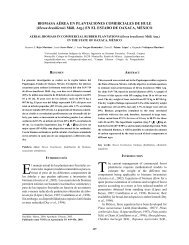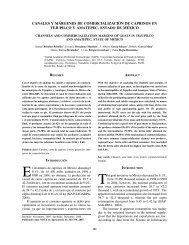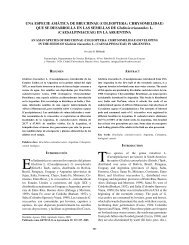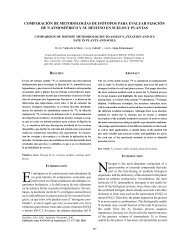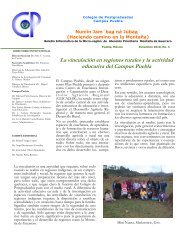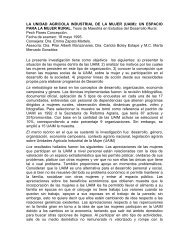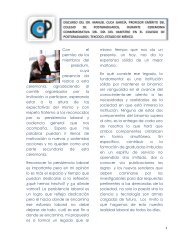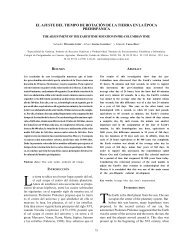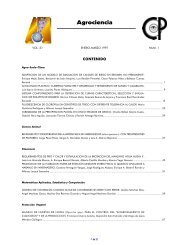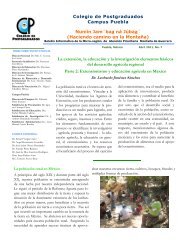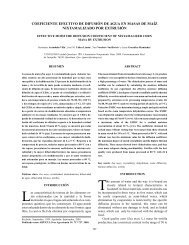AUTO-ACLAREO Y GUÍAS DE DENSIDAD PARA Pinus patula ...
AUTO-ACLAREO Y GUÍAS DE DENSIDAD PARA Pinus patula ...
AUTO-ACLAREO Y GUÍAS DE DENSIDAD PARA Pinus patula ...
Create successful ePaper yourself
Turn your PDF publications into a flip-book with our unique Google optimized e-Paper software.
<strong>AUTO</strong>-<strong>ACLAREO</strong> Y <strong>GUÍAS</strong> <strong>DE</strong> <strong>DE</strong>NSIDAD <strong>PARA</strong> <strong>Pinus</strong> <strong>patula</strong> MEDIANTE EL ENFOQUE <strong>DE</strong> REGRESIÓN <strong>DE</strong> FRONTERA ESTOCÁSTICA<br />
densidad). Este método puede ser una mejor herramienta<br />
analítica para la silvicultura mexicana porque<br />
hay carencia de inventarios de medición continua, y<br />
lo más común es contar con datos provenientes de<br />
sitios temporales de medición, a su vez procedentes<br />
de planes de manejo operativo. Las guías construidas<br />
sugieren además que la intensidad de aclareo para<br />
estos rodales debe ser generalmente fuerte (50 % de<br />
los fustes vivos en cada intervención). Las guías de<br />
densidad construidas constituyen una herramienta<br />
de ayuda para planificar el manejo de la densidad de<br />
rodales coetáneos de <strong>Pinus</strong> <strong>patula</strong> en la región de Zacualtipán,<br />
Hidalgo, México.<br />
lIteRAtuRA cItAdA<br />
Aigner, D., C. A. K. Lovell, and P. Schmidt. 1977. Formulation<br />
and estimation of stochastic frontier production function<br />
models. J. Econ. 6: 21-37.<br />
Bi, H., G. Wan, and N. D. Turvey. 2000. Estimating the selfthinning<br />
boundary line as a density-dependent stochastic<br />
biomass frontier. Ecology 81: 1477-1483.<br />
Bi, H. 2001. The self-thinning surface. For. Sci. 47: 361-370.<br />
Bi, H. 2004. Stochastic frontier analysis of a classic self-thinning<br />
experiment. Austral Ecol. 29: 408-417.<br />
Brescia, V., D. Lema, y E. Barrón. 2003. Dinámica de<br />
producción y eficiencia en empresas agrícolas. Metodología<br />
para el análisis de datos en panel. Documento de Trabajo Nº<br />
29. INTA. 38 p.<br />
Cao, Q. V., and T. J. Dean 2008. Using segmented regression<br />
to model the density-size relationship in direct-seeded slash<br />
pine stands. For. Ecol. Manage. 255: 948-952.<br />
Comeau, P. G., M. White, G. Kerr, and S. E. Hale. 2010.<br />
Maximun density-size relationships for Sitka spruce and<br />
coastal Douglas-fir in Britain and Canada. Forestry 83:<br />
461-468.<br />
Cummings, W., E. Jones, D. Reed, and T. Drummer. 2001.<br />
Frontier function analysis to estimate the maximum relative<br />
growth rate of red pine (<strong>Pinus</strong> resinosa, Ait.) in northern<br />
Michigan. Proceedings of IUFRO S4.11 conference on<br />
Biometry, Modelling and Information Science, University of<br />
Greenwich, London, UK. 8 p.<br />
Daniel, T. W., J. A. Helms, and F. S. Baker. 1979. Principles<br />
of Silviculture. Second Edition. McGraw-Hill. New York,<br />
USA. 500 p.<br />
Del Río, M., G. Montero, and F. Bravo. 2001. Analysis of<br />
diameter-density relationships and self-thinning in non-<br />
thinned even-aged Scots pine stands. For. Ecol. Manage.<br />
142: 79-87.<br />
Drew, T. J., and J. W. Flewelling. 1979. Stand density<br />
management: an alternative approach and its application to<br />
Douglas-fir plantations. For. Sci. 25: 518-532.<br />
Gezan, S. A., A. Ortega, y E. Andenmatten. 2007. Diagramas de<br />
manejo de densidad para renovales de roble, raulí y coigüe en<br />
Chile. Bosque 28: 97-105.<br />
Husch, B., C. I. Miller, and T. W. Beers. 1982. Forest<br />
Mensuration. Third Edition. John Wiley & Sons, Inc. New<br />
York, USA. 402 p.<br />
Kumbhakar, S. C., and C. A. K. Lovell. 2000. Stochastic<br />
Frontier Analysis. Cambridge University Press. New York,<br />
USA. 333 p.<br />
Long, J. N., and J. D. Shaw. 2005. A density management<br />
diagram for even-aged ponderosa pine stands. Western J.<br />
Appl. For. 20: 205-215.<br />
Montero, M. M., H. M. De los Santos-Posadas, y M. Kanninen.<br />
2007. Hyeronima alchorneoides: ecología y silvicultura en<br />
Costa Rica. Serie técnica. Informe técnico/CATIE no. 354.<br />
Turrialba. Costa Rica. 50 p.<br />
Pretzsch, H., and P. Biber. 2005. A re-evaluation of Reineke’s<br />
rule and stand density index. For. Sci. 51: 304-320.<br />
Pretzsch, H. 2009. Forest Dynamics, Growth and Yield: From<br />
Measurement to Model. Springer-Verlag Berlin Heidelberg.<br />
Germany. 664 p.<br />
Reineke, L. H. 1933. Perfecting a stand-density index for evenaged<br />
forests. J. Agric. Res. 46: 627-638.<br />
SAS Institute Inc. 2011. SAS/ETS® 9.3 User’s Guide. Cary, NC:<br />
SAS Institute Inc.<br />
Smith, D. M., B. C. Larson, M. J. Kelty, and P. M. S. Ashton.<br />
1997. The Practice of Silviculture: Applied Forest Ecology.<br />
Ninth Edition. John Wiley & Sons, Inc. New York, USA.<br />
537 p.<br />
Torres, R. J. M., y O. S. T. Magaña. 2001. Evaluación de<br />
Plantaciones Forestales. Editorial. Limusa. México. 472 p.<br />
Vacchiano, G., R. Motta, J. N. Long, and J. D. Shaw. 2008. A<br />
density management diagram for Scots pine (<strong>Pinus</strong> sylvestris<br />
L.): A tool for assessing the forest’s protective effect. For.<br />
Ecol. Manage. 255: 2542-2554.<br />
Yoda, K., T. Kira, H. Ogawa, and K. Hozumi. 1963. Selfthinning<br />
in overcrowded pure stands under cultivated and<br />
natural conditions (Intraspecific competition among higher<br />
plants XI). J. Institute Polytech. Osaka City University,<br />
Series D. 14: 107-129.<br />
Zeide, B. 1987. Analysis of the 3/2 power law of self-thinning.<br />
For. Sci. 33: 517–537.<br />
Zhang, L., H. Bi, J. H. Gove, and L. S. Heath. 2005. A<br />
comparison of alternative methods for estimating the selfthinning<br />
boundary line. Can. J. For. Res. 35: 1507-1514.<br />
SANTIAGO-GARCÍA et al.<br />
89



